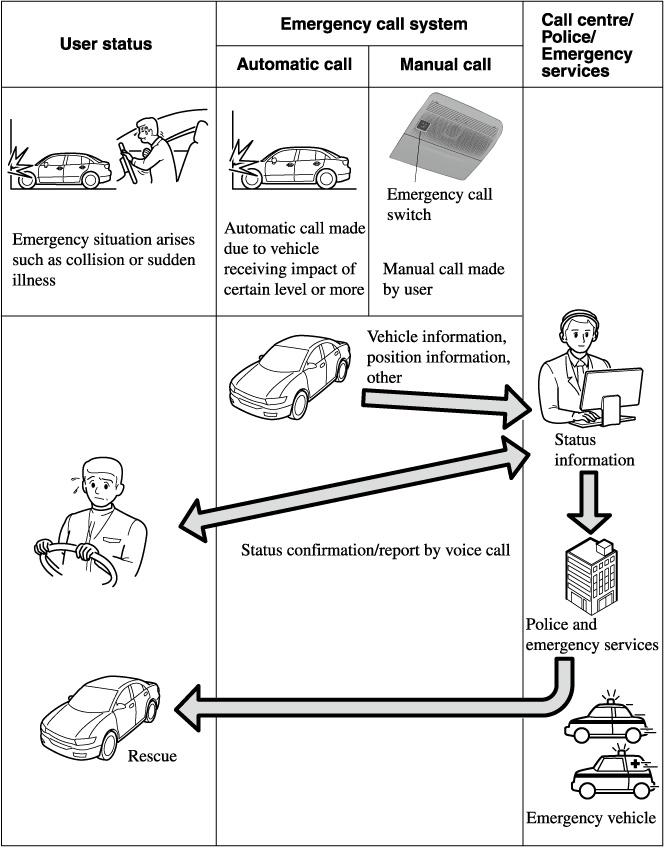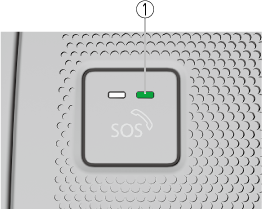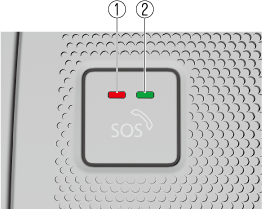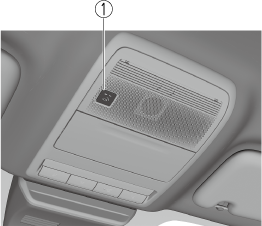

Flow of Emergency call system

-
Do not disassemble the Emergency call system. Otherwise, it could become damaged and may not function in an emergency.
-
The Emergency call system has a special built-in battery so that it can operate even if the power supply from the vehicle is cut such as in an accident.
Heed the following cautions. If the Emergency call system is not used correctly it may not operate.
-
The built-in battery is not a rechargeable type battery. Do not attempt to recharge the battery.
-
The built-in battery life is 3 years. Have the built-in battery replaced at an expert repairer (we recommend an Authorised Mazda Repairer) periodically.
-
If the built-in battery power is low due to natural discharge and the system determines that there is a problem, the Emergency call system cannot be used. If the system determines that there is a problem, the indicator light (red) in the Emergency call switch turns on to notify the driver. Have the vehicle inspected at an expert repairer (we recommend an Authorised Mazda Repairer). Refer to Indicator light/Beep sound (Search).
-
-
The Emergency call system can be used when the ignition is switched ON.
-
There are two ways the Emergency call system makes calls; automatically or manually.
-
The Emergency call system may not make a connection under the following conditions or depending on the use environment. If the Emergency call system does not connect, make a call from another telephone such as the nearest available public telephone.
-
The vehicle is outside of a mobile phone network area
-
The vehicle is in a weak radio wave transmission environment (such as inside tunnels, underground parking areas, shadow of buildings, and mountain areas)
-
The vehicle does not receive an impact of a certain level or more even if an accident has occurred.
-
An extremely serious collision occurs resulting in damage to the Emergency call system.
-
The position information cannot be obtained when signals cannot be received from the GNSS satellites, however, voice calls are possible.
-
-
When a voice call is made by the Emergency call system, the audio system is muted so that it does not interfere with the call.
-
It may take some time for the call centre to respond after the Emergency call system first starts operating.
-
If you are unable to respond to an operator's questions after the voice call begins, the operator may proceed with emergency procedures at their own discretion.
-
Even if it is difficult for you to hear the operator's voice, your voice may be heard by the call centre. Continue explaining your circumstances.
-
If the Emergency call system operates while you are making a call with your mobile phone using Bluetooth® Hands-Free, the call may be interrupted.
-
It may not be possible to receive a call using the Bluetooth® Hands-Free normally while the Emergency call system is operating.
-
A voice call with an operator may not be possible if the speaker or microphone is broken. If the speaker or microphone is broken, always have the vehicle inspected at an expert repairer (we recommend an Authorised Mazda Repairer).
-
The Emergency call system may not operate normally outside of the following temperature range: If the Emergency call system does not operate normally, make a call from another telephone such as the nearest available public telephone.
Operation temperature range: -40 °C (-40 °F) to 85 °C (185 °F)
-
There may be a difference between the position information sent to the call centre and the actual position of the vehicle where the call was made. Indicate landmarks around the position of the vehicle where the call is being made to the operator during the voice call.
Automatic emergency calls
If the vehicle receives an impact of a certain level or more in a collision, vehicle information is automatically sent to the call centre.
When the transmission of the vehicle information is completed or about 20 seconds have elapsed since the transmission began, the voice call with the call centre starts.
If an automatic call is made, the built-in battery power may be depleted and emergency calls may not be possible in the event that an emergency occurs again. After an automatic emergency call has been made, have the built-in battery replaced by an expert repairer (we recommend an Authorised Mazda Repairer).
-
Automatic emergency calls cannot be cancelled by the user.
-
The call centre will end an emergency call. The user cannot end the emergency call.
-
If the vehicle receives an impact of a certain level or more in a collision, an automatic call is made even if the air bags do not deploy.
-
If a call is disconnected or a call cannot be made to the call centre correctly, an automatic call is made again to the call centre. Redialing cannot be cancelled.
-
If the vehicle receives an impact of a certain level or more in a collision, the Emergency call system begins operating automatically.
-
The indicator light (green) on the Emergency call switch flashes slowly (0.5 second intervals) and the call is made to the call centre.

-
Green
-
-
When the connection is established with the call centre, the indicator light (green) flashes somewhat quickly (0.3 second intervals) and the transmission of the vehicle information begins.
-
When the transmission of the vehicle information is completed or about 20 seconds have elapsed since the transmission began, the beep sounds and the voice call with the call centre starts.
-
If the connection fails, the indicator light (red) turns on and the indicator light (green) flashes quickly (0.15 second intervals) and the beep sounds simultaneously.
In this case, make a manual connection using the Emergency call switch because an automatic connection is not possible.

-
Red (Turns on)
-
Green (Flashes)
-
Manual emergency calls
With the ignition switched ON, long-press the Emergency call switch and after releasing your finger from the switch, the vehicle information is automatically transmitted to the call centre.
When the transmission of the vehicle information is completed or about 20 seconds have elapsed since the transmission began, the voice call with the call centre starts.
-
Only make calls manually for conditions requiring urgent treatment such as illness or serious injury.
-
When making emergency calls manually, stop the vehicle in a safe location before making the call.
-
The call centre will end an emergency call. The user cannot end the emergency call.
-
If a call is disconnected or a call cannot be made to the call centre correctly, an automatic call is made again to the call centre.
-
Make sure that the ignition is switched ON.
-
Long-press the Emergency call switch on the overhead console and then release your finger from the switch.

-
Emergency call switch
-
-
The indicator light (green) on the Emergency call switch flashes slowly (0.5 second intervals) and the call is made to the call centre.

-
Green
-
-
When the connection is established with the call centre, the indicator light (green) flashes somewhat quickly (0.3 second intervals) and the transmission of the vehicle information begins.
-
When the transmission of the vehicle information is completed or about 20 seconds have elapsed since the transmission began, the beep sounds and the voice call with the call centre starts.
-
If the connection fails, the indicator light (red) turns on and the indicator light (green) flashes quickly (0.15 second intervals), and the beep sounds simultaneously.
Make a manual emergency call again.

-
Red (Turns on)
-
Green (Flashes)
-
If a call to the call centre does not connect even though the indicator light shows a call is possible, make a call to the police or other authority by means other than the Emergency call system.




